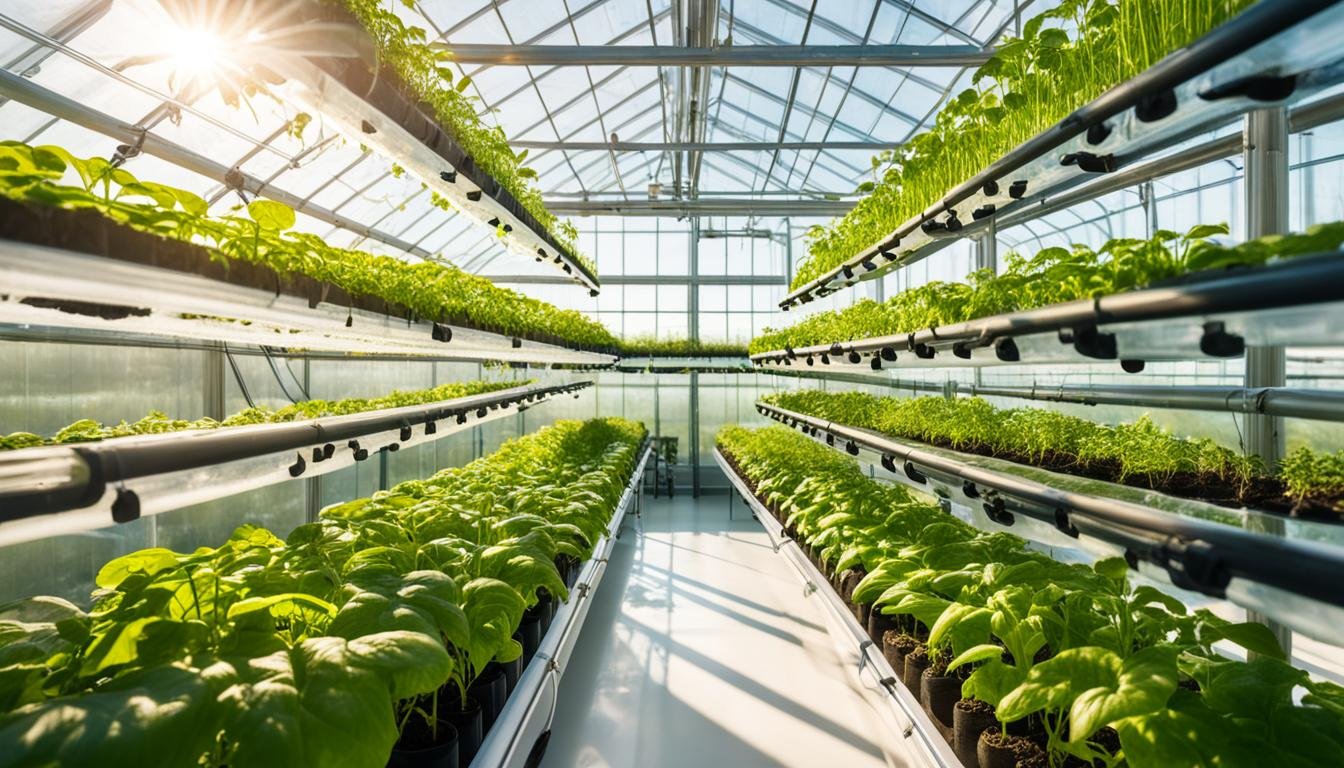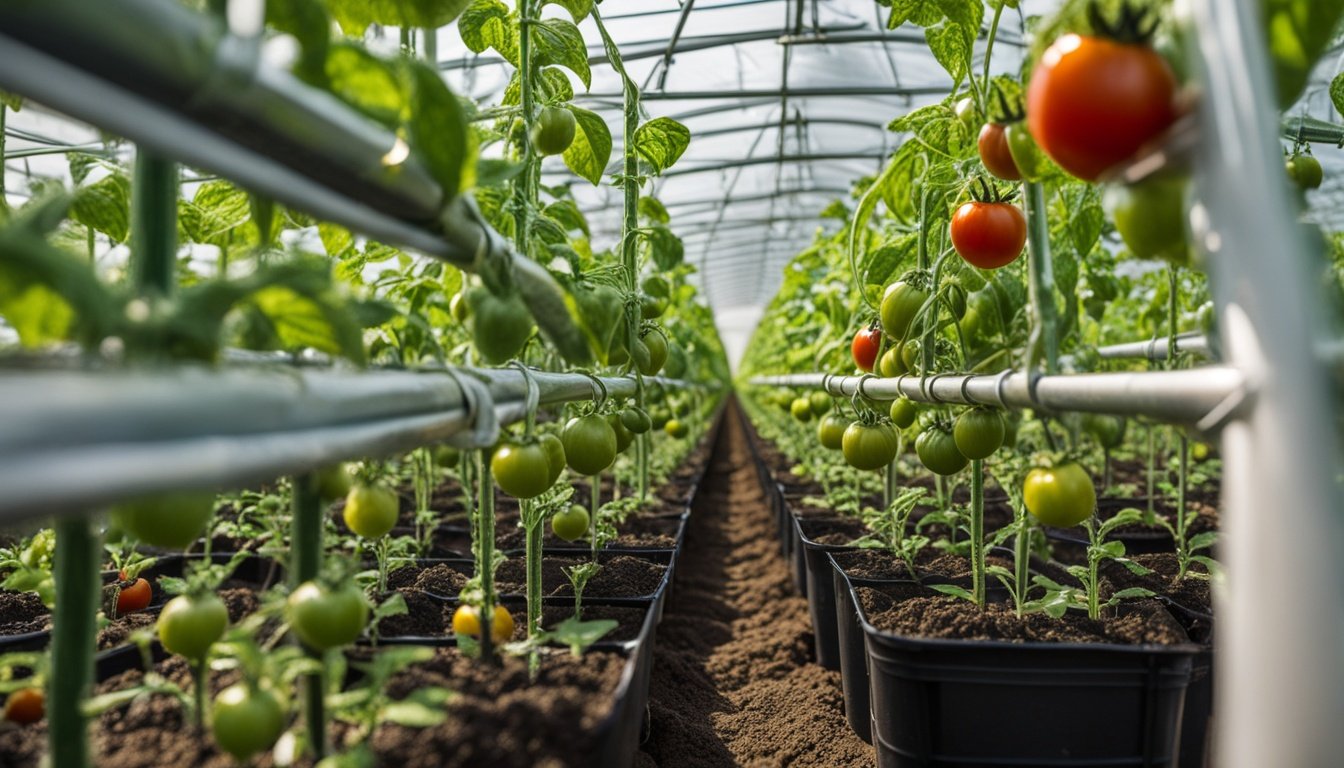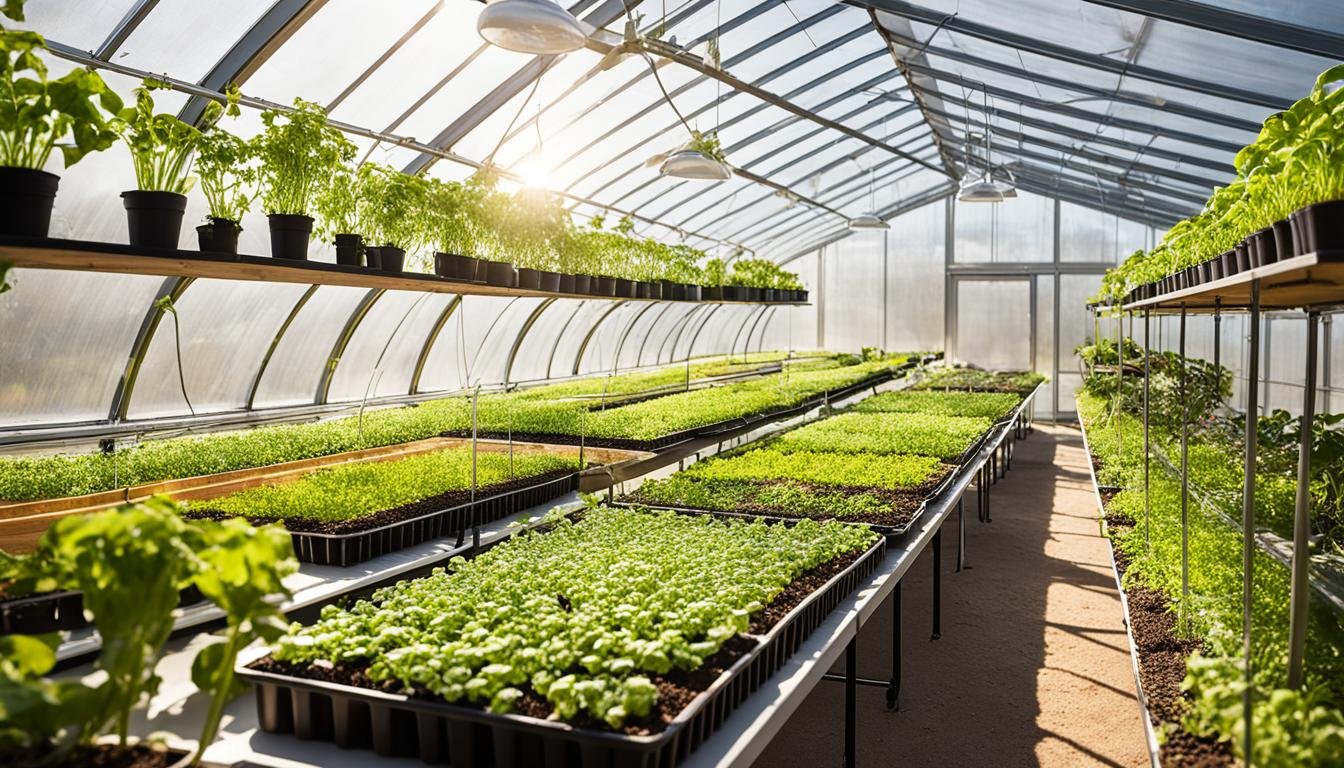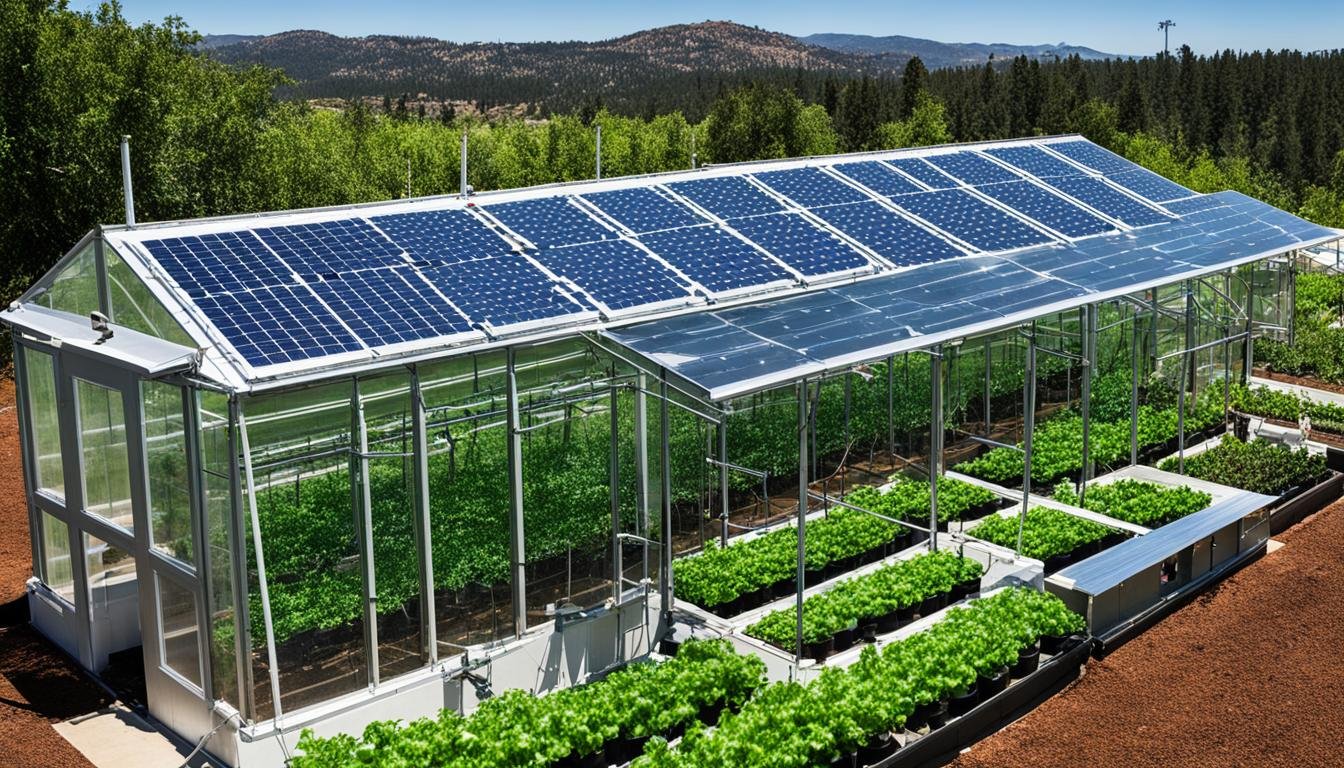Welcome to the amazing world of hydroponics in greenhouses! This guide is your first step into farming sustainable food and crops. You’ll learn about soilless farming and controlled environment agriculture. These methods change how we produce food.
Hydroponics is the modern agricultural choice. It’s better and more efficient than traditional farming. By using hydroponic nutrient solutions in greenhouses, you’ll see big improvements. These include better crop quality, higher yields, and the saving of important resources.
Here, you’ll learn how to grow organic, fresh fruits, veggies, and herbs without soil. We’ll show you the great aspects of greenhouse gardening. You’ll also avoid mistakes many make when starting with greenhouses. This information will save you time and money.
This guide is for anyone keen to start indoor farming or improve their current setup. It gives the knowledge and tools to do well in hydroponics in greenhouses. Let’s start this journey into the limitless world of controlled environment agriculture and soilless farming!
Introduction to Hydroponics and Greenhouse Gardening
Hydroponics and greenhouse gardening change how we grow food. They help the environment and use resources wisely. This method helps crops grow better and saves on water and space. Let’s learn about hydroponics and how it fits with greenhouses.
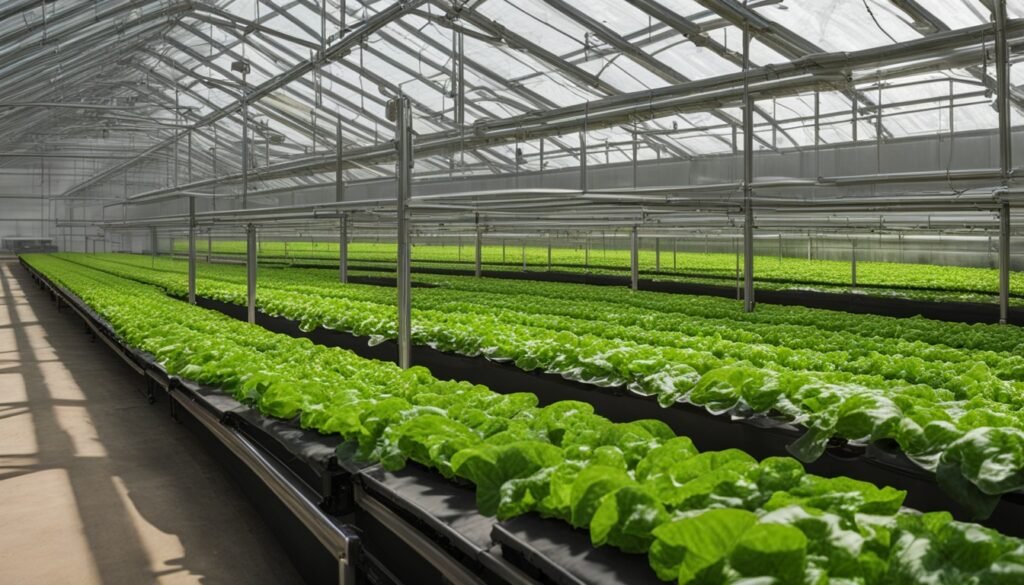
What is Hydroponics?
Hydroponics grows plants without soil, using water with nutrients. Plants grow in this nutrient-rich water or in a soil substitute like rockwool. It controls the amount of nutrients, pH, and oxygen for plants perfectly.
Benefits of Hydroponic Gardening
Hydroponics has many advantages over soil farming:
- Plants grow faster and produce more because they always get the nutrients and water they need.
- It uses water effectively by recycling it in the system.
- It faces fewer plant diseases and pests, resulting in safer food without pesticides.
- Systems can fit more plants in less space, using space well.
| Aspect | Hydroponics | Traditional Soil |
|---|---|---|
| Water Usage | 90% less water | High water consumption |
| Growth Rate | 30-50% faster | Standard growth rate |
| Yield | Up to 10 times higher | Normal yield |
| Pest Control | Reduced pest issues | Higher risk of soil-borne pests |
Advantages of Greenhouse Gardening
Greenhouses protect plants and help them grow longer. Adding hydroponics boosts this further:
- You can grow crops all year, no matter the weather outside.
- It means plants get the perfect amount of heat, light, and humidity.
- They are safe from strong winds, heavy rains, and extreme heat or cold.
- Less chance of pests and plant diseases because the area is closed off.
Hydroponics and greenhouses work great together, making farming more efficient. They use less water and land but grow more food. This way, we can make food in a way that’s good for the planet and our future needs.
Types of Hydroponic Systems
Learning about hydroponic techniques means understanding how to grow plants without soil. There are many methods, such as those that do or do not recirculate water. Each method has its benefits and is good for different plants. We’ll look at popular ways to grow plants without soil and the best parts of each one.
Deep Water Culture (DWC)
Deep Water Culture involves putting plant roots in a water solution rich with nutrients. It’s good for big plants like tomatoes and cucumbers. These plants thrive because they are always in water filled with nutrients. This method helps plants grow quickly and produce a lot of food.
Nutrient Film Technique (NFT)
Nutrient Film Technique flows a thin layer of nutrients over the plant roots. This system is perfect for plants that don’t need much space for their roots, like leafy greens. It’s a hit for big farms because it uses space well and helps plants grow fast.
Ebb and Flow (Flood and Drain)
Ebb and Flow floods the root area with nutrients and then drains it. This back and forth helps roots grow strong and makes sure all plants get food. It’s a simple choice for home growing. You can add features like automatic draining to make it even better.
Drip Systems
Drip systems are simple to use and work with many plants. In this method, water drips onto each plant through tubes. It’s good for saving water and making sure plants get just the right amount of food. The dripping also helps keep the growing area moist.
Aeroponics
In Aeroponics, plant roots are sprayed with nutrients in a closed space. This system is great for many types of plants but needs careful setup. Since there’s no soil, plants get lots of air and food. This helps them grow fast and tall.
| Hydroponic System | Suitable Plant Types | Key Features |
|---|---|---|
| Deep Water Culture (DWC) | Large plants with extensive root systems, such as tomatoes and cucumbers | Roots suspended in nutrient solution, air stones for oxygenation |
| Nutrient Film Technique (NFT) | Plants with smaller root systems, like leafy greens and herbs | Thin film of nutrient solution continuously flows over roots, highly scalable |
| Ebb and Flow (Flood and Drain) | Popular among home hydroponic gardeners, suitable for various plant types | Periodic flooding and draining of grow tray, promotes robust root development |
| Drip Systems | Versatile, suitable for a wide range of plant types | Nutrient solution delivered directly to plant base, precise fertilization and water conservation |
| Aeroponics | Can grow a wide variety of plants, requires careful setup and monitoring | Plant roots misted with nutrient solution, high oxygenation, efficient use of vertical space |
When picking a hydroponic system, think about what plants you want, your space, and design needs. Each method offers something special. By knowing how each system works, you can make a great place for your plants. This lets you grow lots of healthy food all year long.
Setting Up Your Greenhouse for Hydroponics
Setting up a greenhouse for hydroponics needs some steps to get it right. First, think about the design of the greenhouse and how you’ll control the environment. Also, include plans for lighting and ventilation. This way, you’ll make a great spot for your plants to grow big and strong.
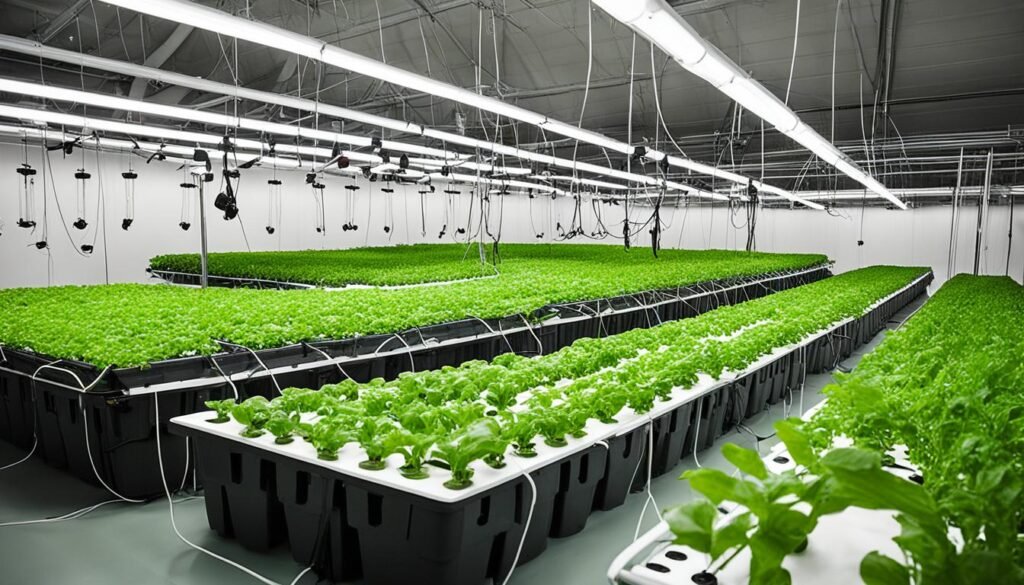
Choosing the Right Greenhouse
Picking out the perfect greenhouse is key for your hydroponic setup. Consider the greenhouse’s size, the materials it’s made from, and where it will be placed. The size should fit what you’re growing and how much. Greenhouses can use glass, polycarbonate, or polyethylene.
Look for a sunny spot that’s easy to get water and power to.
Environmental Control Systems
To keep your plants happy, you need to control the environment. This means watching the temperature, how humid it is, and adding extra CO2. You’ll need things like heaters, fans, and sensors to help with this.
These steps make sure your plants have the best conditions to grow.
Lighting Requirements
Plants need light to grow, and sometimes they need more than the sun can give. You can use LED or HPS lamps to help out. LED lights are great because they don’t use a lot of power and can be set to different colors. HPS lights give off lots of light in many colors, perfect for all stages of plant growth.
When picking lights, think about how bright they are, how much area they cover, and how much electricity they use.
Ventilation and Air Circulation
Air flow is very important in a greenhouse. It keeps the air fresh and helps prevent plant problems. Open vents and windows are good for letting in fresh air and letting out the hot air. Fans can also help move the air and keep it from being too damp.
Adding screens to the windows can keep out pests. With the right plan, your greenhouse will be a perfect home for your plants, making them grow well and yield a lot of produce.
| Component | Key Considerations |
|---|---|
| Greenhouse Structure | Size, materials, location, light transmission, insulation |
| Climate Control | Temperature, humidity, CO2 levels, sensors, automated controls |
| Lighting | LED or HPS lamps, light intensity, coverage area, energy efficiency |
| Ventilation | Natural ventilation, forced air circulation, insect screens, humidity control |
Hydroponic Nutrients and Solutions
In hydroponic systems, the right nutrition for plants is key to growth and health. In these systems, plants don’t get their nutrients from soil like they do in traditional gardening. Instead, they need carefully made solutions. These solutions must meet the plants’ exact needs. Growing successfully means understanding and managing these nutrients well.
Essential Macronutrients and Micronutrients
Plants in hydroponic systems require certain macronutrients for growth. The key macronutrients are nitrogen, phosphorus, and potassium, or NPK. These elements help plants in different ways. Nitrogen is good for leaves, phosphorus for roots and flowers, and potassium boosts overall health. Plants also need secondary nutrients for cell walls, chlorophyll, and proteins. Micronutrients – iron, manganese, zinc, and others – are crucial in tiny amounts for plant functions. By ensuring the right mix of these nutrients, growers support strong, productive plants.
pH and EC Management
It’s vital to control the pH and EC of nutrient solutions. The best pH for most hydroponic plants is 5.5 to 6.5. This range makes essential nutrients most available. EC measures the solution’s solids and must also be right for the plants. Growers adjust pH and EC using products made for this. Keeping an eye on the water’s quality helps plants grow well.
Preparing Nutrient Solutions
Nutrients can come from ready-made blends or homemade mixes. Following directions is a must when using concentrated formulas. Yet, some mix their own solutions knowing the plants’ exact needs. It’s important to keep the solution in check by testing the pH and EC, and topping up nutrients. This care ensures plant health and growth.
